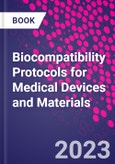Biocompatibility Protocols for Medical Devices and Materials provides comprehensive coverage of the basic science and toxicological testing protocols necessary for the risk assessment and safety analysis of medical devices and materials which are based on the ISO guidelines for body contact and duration of contact. The book begins with device/component selection for toxicological experiments and provides an introduction to topics such as sensitization, irritation tests, material-mediated pyrogenicity, and bacterial-mediated pyrogenicity. Toxicology-related chapters explain the protocols for cytotoxicity, acute systemic toxicity, repeated-exposure systemic toxicity, genotoxicity, carcinogenicity, and reproductive toxicity testing.
Biocompatibility Protocols for Medical Devices and Materials is a practical guide that provides step-by-step toxicological protocols ranging from materials selection to data interpretation for toxicologists, biomedical researchers, healthcare professionals, product developers, and others working in risk assessment and safety analysis of medical devices.
Please Note: This is an On Demand product, delivery may take up to 11 working days after payment has been received.
Table of Contents
Contributors
Author bios
Introduction
1.Cytotoxicity
Prakash Srinivasan Timiri Shanmugam, Thamizharasan Sampath, Indumathy Jagadeeswaran, Sandhiya Thamizharasan, Safura Fathima and Krithaksha V.
Introduction
ISO 10993-5
Cytotoxicity
Detection methods
Test by indirect contact
Quantitative method
Abbreviations
References
2. Sensitization
Prakash Srinivasan Timiri Shanmugam, Thamizharasan Sampath, Indumathy Jagadeeswaran, Sandhiya Thamizharasan and Safura Fathima
Introduction�
ISO 10993-10�
Test methods�
Guinea pig tests�
Guinea pig tests and sensitization potency assessment�
Guinea pig maximization and Buehler tests�
Open epicutaneous test�
Advantages and limitations�
Local lymph node assay�
The LLNA and sensitization potency assessment�
Advantages and limitations�
Human skin-sensitization testing�
Advantages and limitations�
Application of test methods in risk assessment�
Guinea pig tests�
Local lymph node assay�
Human repeat-insult patch test
Abbreviation�
References�
3. Irritation test
Prakash Srinivasan Timiri Shanmugam, Thamizharasan Sampath and Indumathy Jagadeeswaran
Introduction�
Selection of animals�
Test procedure�
Alternative methods�
In vitro tests methods for irritation�
References�
4. Material-mediated pyrogenicity
Prakash Srinivasan Timiri Shanmugam, Thamizharasan Sampath, Indumathy Jagadeeswaran, Sandhiya Thamizharasan and Safura Fathima
Introduction�
Broad range of pyrogens�
Tests using fluid extracts�
Selection of animal species�
Animal status�
Animal care and husbandry�
Size of groups�
Number of groups�
Treatment controls�
Route of exposure�
Test sample administration�
Pyrogen tests�
LAL test�
Rabbit test: sham test (in vivo)�
Interpretation of results�
Monocyte activation test (in vitro test)�
Procedure of MAT�
Advantages�
Abbreviations�
References�
5. Acute systemic toxicity
Prakash Srinivasan Timiri Shanmugam, Thamizharasan Sampath and Indumathy Jagadeeswaran
Introduction�
Considerations�
Acute systemic toxicity�
Selection of animals�
Animal status�
Animal care and husbandry�
Size and number of groups�
Routes of exposure�
Dosing�
Body weight and food/water consumption�
Clinical observations�
Clinical pathology�
Anatomic pathology�
Evaluation criteria�
Final report�
References�
6. Repeated-exposure systemic toxicity (subacute, subchronic, and chronic systemic toxicity)
Prakash Srinivasan Timiri Shanmugam, Thamizharasan Sampath, Indumathy Jagadeeswaran and Harini Sriram
Introduction�
Animal care and husbandry�
Size and number of groups�
Routes of exposure�
Dosing�
Clinical observations�
Clinical pathology�
Anatomic pathology�
Evaluation criteria�
Final report�
References�
7. Implantation
Prakash Srinivasan Timiri Shanmugam, Thamizharasan Sampath and Indumathy Jagadeeswaran
Introduction�
Selection of animals�
Test procedure�
References�
8. Hemocompatibility
Prakash Srinivasan Timiri Shanmugam, Thamizharasan Sampath, Indumathy Jagadeeswaran, Krithaksha V., Vinod P. Bhalerao and Sandhiya Thamizharasan
Highlights�
Introduction�
Types of devices in contact with blood�
Characterization of blood interactions�
Categories of tests and blood interactions�
Preclinical evaluation of cardiovascular devices and prostheses�
Advantages and limitations of animal and in vitro testing�
Laboratory testsdprinciples, scientific basis, and interpretation�
Evaluation of hemolytic properties of medical devices and their components�
Hemolysis testingdgeneral considerations�
Abbreviations�
References�
9. Tests for genotoxicity
Prakash Srinivasan Timiri Shanmugam, Thamizharasan Sampath, Indumathy Jagadeeswaran and Harini Sriram
Introduction�
Requirements�
Genotoxicity�
Example test method: mouse lymphoma mutagenesis assay�
Evaluation criteria�
Results�
Conclusion�
References�
10. Carcinogenicity
Prakash Srinivasan Timiri Shanmugam, Thamizharasan Sampath, Indumathy Jagadeeswaran, Safura Fathima and Sandhiya Thamizharasan
Introduction�
Carcinogenicity test-specific considerations�
Abbreviations�
References�
11. Reproduction toxicity
Prakash Srinivasan Timiri Shanmugam, Thamizharasan Sampath, Indumathy Jagadeeswaran, Sandhiya Thamizharasan and Safura Fathima
Introduction�
Principle of the test�
Description of the method�
Procedure�
Data and reporting�
Abbreviations�
References�
12. Toxicokinetics
Prakash Srinivasan Timiri Shanmugam, Thamizharasan Sampath, Indumathy Jagadeeswaran, Vinod P. Bhalerao, Sandhiya Thamizharasan, Krithaksha V. and Jayanta Saha
Introduction�
Principles for design of toxicokinetic studies�
Guidance on test methods�
Toxicokinetic study sampling�
Toxicokinetic study report�
Guidance on specific types of test�
Absorption�
Distribution�
Metabolism and excretion�
Abbreviations�
References�
13. Data leverage
Prakash Srinivasan Timiri Shanmugam, Thamizharasan Sampath and Indumathy Jagadeeswaran
Introduction�
Leverage from literature�
Leverage from Threshold of Toxicological Concern (TTC)�
Leverage from reviewed devices�
Leverage from vendors testing�
References�
14. Chemical characterization
Prakash Srinivasan Timiri Shanmugam, Thamizharasan Sampath, Indumathy Jagadeeswaran, Sandhiya Thamizharasan and Krithaksha V.
Introduction�
Why characterize materials?�
Chemical characterization�
Material characterization�
Plasticizers�
Sterilization techniques used for medical devices�
Corrosion�
Extractables and leachables�
Set up a chemical characterization study�
Conclusion�
References�
15. Biological evaluation report
Prakash Srinivasan Timiri Shanmugam, Thamizharasan Sampath and Indumathy Jagadeeswaran
Contents�
Index�








